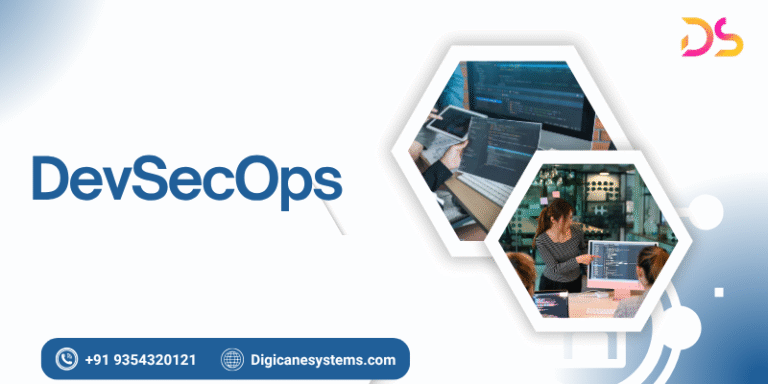DevSecOps: Embedding Security in Every Phase of Development
DevSecOps is a forward-thinking method that unites coding, protection, and system management. It guarantees that security is woven into every stage of software production. Unlike older ways, it does not treat security as a last-minute task. At Digicane Systems, we see DevSecOps as crucial for crafting secure and trustworthy software at speed. This article explores DevSecOps, its core concepts, advantages, and how to practice it efficiently.
What is DevSecOps?
DevSecOps stands for Development, Security, and Operations. It builds on DevOps by infusing security throughout the workflow. The aim is to make protection a joint duty for all participants. Instead of delaying checks, security reviews happen constantly. This method helps spot and resolve threats early, saving time and avoiding bigger issues later.

Key Principles and Goals of DevSecOps
- Shift-left security: Place security checks at the earliest possible point.
- Continuous security: Automate protection steps at each milestone.
- Teamwork: Developers, security staff, and operators act as a single unit.
- Automation: Employ tools to accelerate safety without slowing progress.
- Compliance: Make sure all software aligns with legal and company policies.
Core Components of DevSecOps
People:
Everyone must value security. Teams should share insights and work hand-in-hand.
Processes:
Security must be included in every phase, from writing code to launching updates.
Technology/Tools:
Use automated solutions for scanning code, finding weaknesses, and overseeing systems.
Governance:
Establish firm guidelines and standards for safe development and operations.
Automation:
Automate routine security duties to minimize mistakes and enhance speed.
DevSecOps Lifecycle: Stages and Best Practices
Planning:
Spot security needs early. Set rules and compliance targets upfront.
Coding:
Adopt secure coding habits. Use peer reviews and static analysis programs.
Building:
Run automated scans to catch flaws before going live.
Testing:
Apply both dynamic and static tests to uncover hidden dangers.
Deployment:
Release with security checks active. Use safe settings and controls.
Monitoring:
Keep watch for threats and act fast when issues arise.
Feedback:
Gather insights and refine security practices regularly.
Best Practices for Effective DevSecOps Implementation
- Automate security checks: Use tools to inspect code and infrastructure.
- Manage risks: Track weaknesses, especially in outside software.
- Centralize issue tracking: Resolve problems quickly and smoothly.
- Threat modeling: Predict risks before any code is written.
- Educate teams: Keep everyone informed on the latest security methods.
Key Features and Tools in DevSecOps
- Static Application Security Testing (SAST): Examines code for defects before use.
- Dynamic Application Security Testing (DAST): Checks running apps for security gaps.
- Software Composition Analysis (SCA): Reviews third-party modules for issues.
- Infrastructure as Code (IaC) Testing: Checks infrastructure blueprints for errors.
- Container Security: Guards container-based environments.
- CI/CD Integration: Automates security in building and launching software.
- Monitoring Tools: Spot and respond to threats as they happen.
Benefits of DevSecOps
- Quicker software releases:
Automated security moves releases forward without hold-ups. - Fewer vulnerabilities:
Early discovery lowers the risk of breaches. - Stronger collaboration:
Teams share responsibility, raising overall security standards. - Better compliance:
Automated checks help meet rules and regulations with ease. - More transparency:
Ongoing monitoring gives real-time security updates.
Challenges in Adopting DevSecOps
- Cultural shift:
Changing attitudes to embrace shared security can be tough. - Tool coordination:
Merging several security tools into workflows is often tricky. - Balancing pace and safety:
Finding the right balance needs careful planning.
At Digicane Systems, we support organizations in overcoming these obstacles with custom strategies and expert support.
Conclusion
DevSecOps is vital for producing secure software swiftly. It blends security into each step, making it a shared task. By following best practices and choosing the right tools, teams can reduce risks and boost software dependability. Digicane Systems is dedicated to guiding businesses on their DevSecOps journey. Adopt this approach to stay ahead in today’s rapid digital landscape.
FAQs
Q: How does DevSecOps differ from DevOps?
A: DevSecOps weaves security into every DevOps process as a core element.
Q: Is DevSecOps suitable for small teams?
A: Yes, its automation and teamwork make it fit for any team size.
Q: Which tools are key for DevSecOps?
A: Tools for code review, vulnerability scanning, and CI/CD automation.






